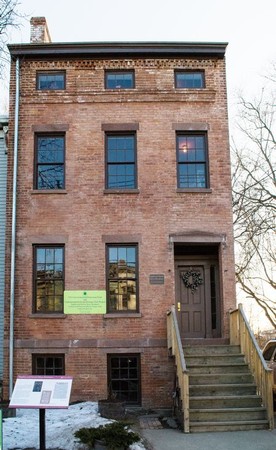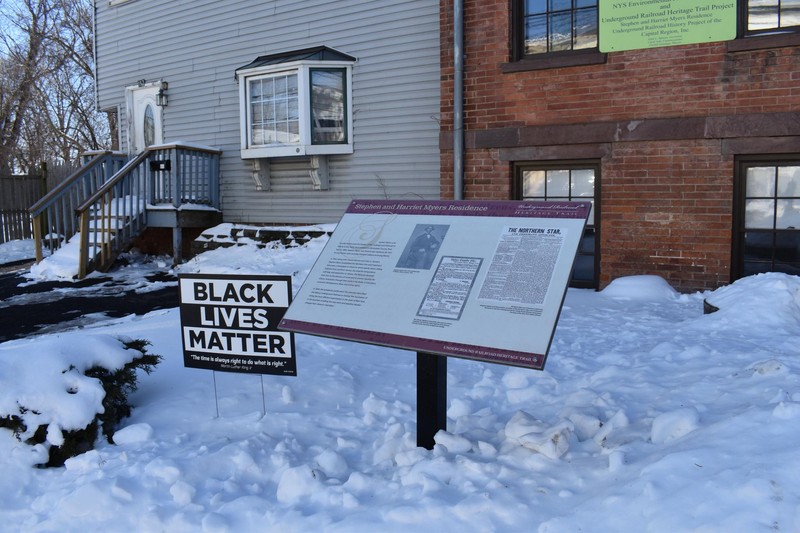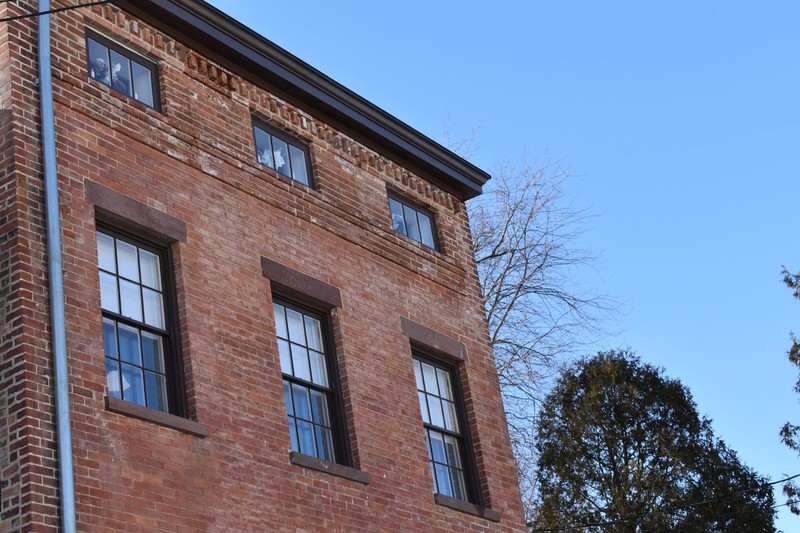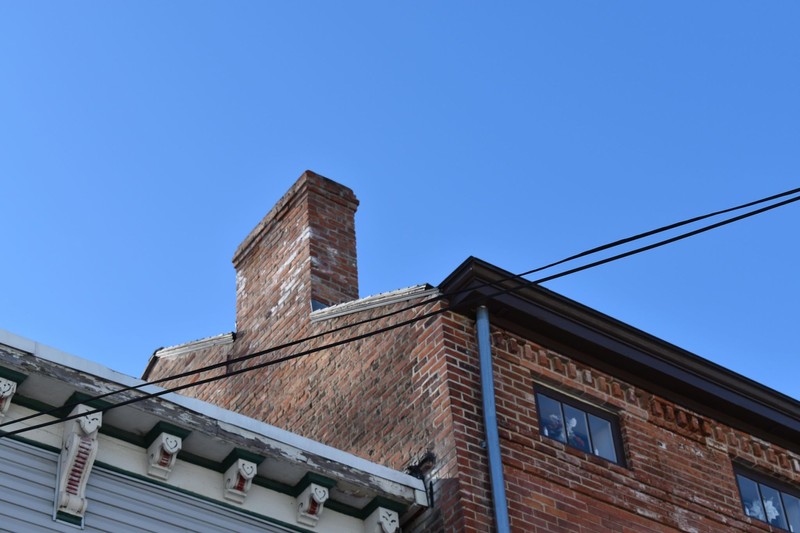194 Livingston Avenue - Underground Railroad Education Center/Stephen & Harriet Myers Residence
Introduction
Author-Uploaded Audio
Listen to a narration of this entry's description by Kim Parker .
Text-to-speech Audio
This recently restored building in the Arbor Hill neighborhood of Albany was once the residence of Stephen and Harriet Myers; abolitionists and central figures in the northeastern New York Underground Railroad. Built in 1847 by African American sloop captain John Johnson, Stephen and Harriet Myers lived here during the 1850s with their children. The home was notably used as the office and meeting place of the Vigilance Committee, which provided assistance to freedom seekers during the mid-19th century. After years of neglect, the Underground Railroad History Project of the Capital Region, Inc. purchased the property in 2004 with hopes to restore it and use it as an educational space. It is both historically & architecturally significant: a highly intact example of a mid-nineteenth-century brick Greek Revival home and a building that tells an important tale about this movement (now home to the Underground Railroad Education Center). It was added to the State and National Register of Historic Places in 2004, and although the organization has made great progress the restoration process is not yet complete - please see their website below to donate.
Images
Front of 194 Livingston Ave

Stephen Myers

Stephen & Harriet Myers Residence plaque


.jpg)



.jpg)



Backstory and Context
Author-Uploaded Audio
Listen to a narration of this entry's description by Kim Parker .
Text-to-speech Audio
The entire city of Albany went through a major transformation with the completion of the Erie Canal in 1825. The canal inlet and the Albany Basin were in very close proximity to the area of Broadway and Livingston Ave; because of this there was an increase in commercial, industrial, and residential development following the canal’s completion. Around this time, Livingston Avenue was known as Lumber Street, as it dead-ended at the city’s lumber district (making the original address of this property 198 Lumber Street).
The home that became the residence of Stephen and Harriet Myers was built in 1847 by Captain John Johnson. Johnson had been appointed captain of the sloop Miriam by his father Captain Abraham, and he traveled back and forth between Albany and New York City for trade. By the 1850s, Stephen and Harriet became tenants of the home with their children. It is believed that Harriet Myers (née Johnson) was Captain Johnson’s sister.
Stephen Myers was born in Rensselaer County in 1800 as a slave. He was emancipated in 1818 at the age of eighteen, and by 1827 he had married Harriet Johnson. For a time he worked as a grocer and steamboat steward before beginning his journalistic enterprise in 1842. He used his own resources and the Northern Star Association, which he headed, to publish a paper called the 'Northern Star and Freemen’s Advocate'. This paper provided a prominent voice for freedom and African American rights. Harriet worked with him on the paper, and they moved into 194 Livingston Ave soon after in the 1850’s. The building grew to become more than just a home, becoming a refuge for people escaping enslavement. It was used as the office and meeting place of the Vigilance Committee, which provided legal assistance, food, clothing, money, employment, and temporary shelter to freedom seekers. Under Myers’ leadership as chairman, the Albany branch of the Underground Railroad was often considered to be the best run segment in the state.
Stephen continued to edit and publish papers throughout his lifetime; he was involved with the 'Telegraph' and 'Temperance Journal' and 'Circular to the Friends of Freedom'. He is also frequently referenced in newspapers of the time as a speaker and representative at conferences in the Albany area and beyond. He often shared the podium with Frederick Douglass (another prominent activist) both when Douglass spoke in Albany and in other locations. Both Stephen and Harriet were advocates of education and self-sufficiency for African Americans, along with other civil rights, playing a significant role in the Underground Railroad movement.
Unfortunately, by the middle of the twentieth century, the building was vacant and had fallen into decline. In 2004, the Underground Railroad History Project of the Capital Region, Inc. purchased the home to restore it, and it was saved from demolition. The organization began the restoration project in 2007, and improvements are still being made to this day.
This structure is a wonderful example of Greek Revival architecture, thanks in part to the restoration it has undergone. Its configuration of 2 1/2 stories over a raised basement, tripartite arrangement of windows, simple rectangular lintels and sills, recessed doorway, and frieze and frieze band windows with a dentilled cornice are all consistent with this style.
Since its purchase in 2004, the home has been listed on the State and National Register of Historic Places, and now serves the community as a cultural and historic museum where the public can learn about the building’s role in the civil rights movement, as well as the story of the people whom this monument to freedom helped.
Sources
Demare, Carol. "Saving Underground Railroad Haven." Times Union (Albany, NY), April 11, 2011. https://www.timesunion.com/local/article/Saving-Underground-Railroad-haven-1324392.php.
"Historical Black Mariners of the Hudson Valley: Captains Abraham and John Johnson." Hudson River Sloop Clearwater Inc. Accessed February 25, 2021. https://www.clearwater.org/clearwater-blog/highlighting-the-voices-of-the-unheard-historical-Black-mariners-of-the-hudson-valley/.
"Key People: Stephen Myers - Black Abolitionist Leading Figure of the Local UGR." Underground Railroad Education Center. Accessed February 25, 2021. https://undergroundrailroadhistory.org/key-people/#1581957855342-5f98db29-a4ab.
New York State Historic Preservation Office. Stephen Myers Residence. CRIS Entry 00140.004647.
"Stephen and Harriet Myers Residence." Hudson River Valley National Heritage Area. Accessed February 25, 2021. https://www.hudsonrivervalley.com/sites/Stephen-and-Harriet-Myers-Residence1/details.
"Stephen and Harriet Myers Residence." Underground Railroad Education Center. Accessed February 25, 2021. https://undergroundrailroadhistory.org/residence/.
Tilly, Stephen, "Historic Structure Report, Stephen and Harriet Myers Residence, Albany, New York." Dobbs Ferry, NY, February 5, 2009. https://undergroundrailroadhistory.org/wp-content/uploads/2020/04/HSR-Historic-Structures-Report.pdf.
"Underground Railroad Education Center." Discover Albany. Accessed February 27, 2021. https://www.albany.org/listing/underground-railroad-education-center/930/.
https://www.hudsonrivervalley.com/sites/Stephen-and-Harriet-Myers-Residence1/details
https://www.blackpast.org/african-american-history/myers-stephen-1800-1870/
https://www.reneeater.com/on-monuments-blog/2019/9/29/ny-state-network-to-freedom-stephen-and-harriet-myers-residence-albany
Historic Albany Foundation
Historic Albany Foundation
Historic Albany Foundation
Historic Albany Foundation
Historic Albany Foundation
Historic Albany Foundation
Historic Albany Foundation
Historic Albany Foundation
Historic Albany Foundation
